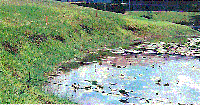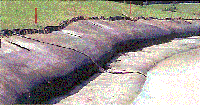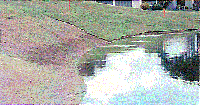|
|
 |
Soil erosion costs homeowners millions of dollars a year. Soil loss not only causes damage to roads and property but eventually finds its way to a lake, pond, river or stream. It contributes to the phosphorus load and can result in algae blooms. In addition, soil removal from roadside ditches and storm drains is required, costing taxpayers money.
Your property may be only one small part of the big picture but collectively, with other homes, it can represent a significant source of nutrient pollution and soil erosion, Nature slowly wears away land, but human activities,
such as construction, increase the rate of erosion 200 or even 2000 times nature's rate.
Are you planning to build a new home, camp or an addition? Thinking of installing a driveway or garage? Are you planning earth-moving activities such as upgrading or replacing a septic system? Here are some tips to consider BEFORE CONSTRUCTION.
1. Determine if the soils on your selected site are really suited for the proposed use. Consult your county soil survey (available at the local Soil and Water Conservation District) to find out what kind of soil you have and its limitations. Avoid disturbing wet areas, steep slopes, drainageways, unstable soils, areas subject to flooding, stream banks or edges, and lakeshores.
2. Become familiar with the natural drainage patterns of the property and try to avoid altering them. Proper site design will help you avoid expensive erosion control measures.
3. Contact your town office or code enforcement officer for any necessary permits or applications. Contact the DEP for projects within 100 feet of a water body or wetland.
4. Plan to preserve existing vegetation as much as possible. Vegetation will naturally curb erosion, improve the appearance and the value of your property, and reduce the cost of landscaping later. Wide buffer strips of undisturbed vegetation are required along stream and lakeshores. Don't allow heavy machinery to operate in these buffer areas.Discuss clearing limits with your contractor in advance. Field mark these limits with ribbons or flagging. Flag particular trees and shrubs that you want protected. Remember that heavy machinery must be kept well away from trees to avoid compacting their roots; otherwise, they will die a few years later. Trees roots can also smother if excess fill is re-graded around them.
5. Consult with your construction contractor(s). Make sure everyone understands exactly what the job is, when it will be done, how long it will take, and what erosion control measures will be used.
6. Plan earth-moving activities early enough so that you can revegetate the site ASAP. Plan to mulch disturbed areas if construction is delayed. This will protect bare soil from rain water runoff.
7. Machinery must not be allowed 'to cross streams. Major damage to stream banksoccurs when heavy equipment is carelessly run in stream channels.
If access across a stream is needed, plan for a temporary culvert and stream crossing that can be removed later.Here are some tips to consider DURING CONSTRUCTION.
1. Before doing anything else, install a filter barrier on the downslope side of the construction area. This barrier can be either a silt fence, an embedded hay bale barrier, or a combination of the two. Filter fence is better at filtering out soil from water, but is easily pushed over by construction equipment. Hay bales don't filter dirty water as well, but are more rugged in the field. When working in a critical area (next to streams and ponds) use them both. Trench sift fencing in about 6 inches. Trench and stake hay bales (4-inch trench, 2 stakes per bale). Hay bales and silt fencing don't work unless they are installed properly and maintained!
2. If possible when earth moving, separate topsoil so it can be spread back on top of the site. You'll have greater success in establishing a new lawn or buffer strip area, and you won't have the added expense of buying topsoil. Ring the downslope edge of topsoil stockpiles with silt fencing or embedded hay bales. Take a soil sample and send it for testing to determine how much fertilizer and time you'll need for your replanting. Soil test kits are available from the local office of the University of Maine Cooperative Extension Service.
3. Use mulch hay liberally on disturbed soil during the construction period to avoid having an erosion problem. Hay mulch is the cheapest and most effective way ofprotecting the soil. Be aware of the weather forecast and be sure to get your mulch out if rains are expected. Don't let a week pass without mulching
4. Construct suitable runoff and erosion control structures. Consult with an engineer for sites with very erodible soils, steep slopes, natural springs and seeps, and spring runoff channels and streams.
• Culverts are used where a driveway enters a main road. The minimum size should be 12" in diameter. A "rule of thumb" for estimating culvert size for watersheds smaller than 7 acres is to add 8 to the number of acres in the watershed to determine culvert diameter. For example, a 7 acre watershed + 8 =15" diameter culvert. Larger culverts should be designed by a professional engineer. Generally, the entrance and the exit areas of a culvert should be reinforced by stone (riprap).
• Grassed ditches or waterways can be used to channel moderate water flows. Be sure to line the base of new channels with excelsior mesh or use a combination of mulch arid biodegradable netting to hold the soil until grass is established. Contact an engineer for ditches on steep slopes (greater than 5°/0) or ditches that will carry a steady flow of water.
• Diversions are similar to waterways but they take water across a slope, diverting it away from a critical area. A ridge or berm is constructed on the low side to intercept water.
• Structures such as stone (riprap) channels, catch basins, or pipe systems are used to carry large, concentrated flows down a steep slope. These should be designed by an engineer.
• Cut and fill slopes should be a maximum of 2:1(2 horizontal to 1 vertical) if vegetation will be used to stabilize them. Steeper slopes generally will need riprap or other structural modifications.
If a lot of water comes down the slope,you also may need riprap. Consult an engineer in these cases.Here are some tips to consider AFTER CONSTRUCTION.
1. When the earthmoving is completed, replant the anal. Don't automatically plant the area to grass - consider replacing the native frees and shrubs. These species are generally better at taking up pollutants and nutrients in storm runoff water.
2. Use your soil test results to determine fertilizer and lime needs. Be extremely careful when using fertilizers near streams, lakes and ponds. Don't apply before a storm. Use formulations very low in phosphorus in these areas.
3. Always mulch new seedings. Apply mulch hay or straw at a rate of two bales per 1000 square feet. Wet the mulch down with water to hold it in place in flat areas. To hold the mulch down on steep slopes or in the bases of ditches, tack biodegradable netting over it, punch it into the soil with a shovel or roller, or stake it with baling twine. On very steep slopes, you may need erosion control mats such as excelsior. Your mulch is only as effective as your mulch anchoring. If mulch isn'tanchored properly, the soil and seed will wash away. When using erosion control nets and mats, be sure to install them according to the manufacturer's recommendations. Otherwise, they generally won't work and your money is wasted.
4. Check before storms to see that your silt fencing and hay bales are in good condition and ready for action. Check and repair them again after storms. Remove sediment that has acccumulated. Replace silt fencing that no longer allows water to filter through it. If the barriers are being undercut at the edges, they should be replaced by a stone check dam.
|
| |
Concrete Mat |
Riprap |
Bulkhead/Seawall |
Geotec-Tube |
| Life Span (years) |
35 |
30 |
20 |
20+ Year Life Span |
| Cost Per Linear Foot |
$130 |
$150 |
$200 |
FREE on site quotes |
| Aesthetic Quality |
Poor |
Fair |
Fair |
Excellent Aesthetic Quality |
Learn More About Advantages of Erosion Cotrol & Repair:
Our primary objective is to meet the growing demand for cost effective shoreline erosion contol and repair. Because of past
unrestricted dredging by developers for fill to build upon, shoreline erosion has affected most all developments,
homeowners associations, golf courses, and private residences throughout the southern United States.
The Florida Water Management Districts (FWMD) has "set the standard" regarding the installation of ALL methods of erosion repair. Studies have shown that the Geotec Tube system is the most cost
effective long-term option accepted by the SFWMD. Having proven itself over many years.
ASR has decided to focus primarily on the Geotec Tube system.
ASR has a working relationship with engineers from the Florida Water Management Districts through out the State of Florida. ASR values this relationship and will continue to meet or exceed their specs for the Geotec-Tube method of shoreline maintenance.
Erosion control is the practice of preventing or controlling wind or water erosion in agriculture, land development and construction. This sometimes involves the creation of a physical barrier, such as vegetation or rock, to absorb some of the energy of the wind or water that is causing the erosion. Effective erosion controls are important techniques in preventing water pollution and soil loss. Erosion control may arise in natural areas, agricultural settings or urban environments, the latter of which is often characterized as stormwater runoff driven. On construction sites they are often implemented in conjunction with sediment controls such as sediment basins and silt fences.
American Shoreline Resorations' erosion control methods include:
American Shoreline Restoration is proud to offer the Geotec Tube Erosion Control System. At 25% of the cost of conventional bulkheads or seawalls, the Geotec Tube is the most cost effective and environmentally responsible shore line erosion control system available.
Shoreline erosion is a serious issue in Florida, and continues to grow worse due to poor lake development standards, hurricanes and heavy rain. Erosion control is easily solved by installation of the Geotec Tube erosion control system. Shoreline restoration is also easily achieved by the installation of the Geotec Tube erosion control system.
The Geotec Tube is constructed from the highest quality Polypropylene non-woven geotextile sewn together to form a custom diameter tube. The tube is interconnected along the waters edge, then a small sand pump is used to fill the tube with the same sand and organic material that has been eroding into the lake or canal. The final result is a long lasting fully contained sand filter barrier that will stabilize the bank from erosion and filter rainwater and irrigation run off.
The Geotec Tube erosion barrier can be installed on any shoreline contour or stacked pyramid fashion to create a more substantial barrier to protect against soil erosion during heavy rains. Once the Geotec Tube is sodded, the durability and life span is unlimited. Shoreline restoration is easy to obtain and erosion control has never been more simple.
CALL TOLL FREE: 1-888-753-7633
Cellular confinement systems are widely used in construction for erosion control, soil stabilization on flat ground and steep slopes, flexible channel linings, load support and earth retention. Typical cellular confinement systems such as our Geotec Tube System that are expanded on-site using exsisting silt from the pond, lake or canal to form a honeycomb-like structure which may be filled with sand, soil, rock .The systems were originally designed by the United States Army Corps of Engineers for use in Operation: Desert Storm as a soil stabilization method for moving heavy equipment through soft desert sands.[
American Shoreline Restoration ASR is the leader in affordable shoreline restoration. ASR is family owned & operated and focuses mainly on
Geotec Tube erosion control system installations. The Geotec Tube is installed from the water with no impact on existing landscape or property use. Geotec Tube erosion control applications include hundreds of golf courses, city, county and state governmental agencies, as well as homeowners associations, private residence and Orlando theme parks.
|




